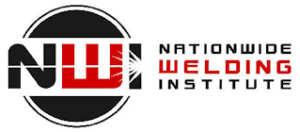Training Courses
TIG
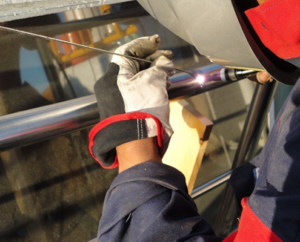 TIG welding is an electric arc welding process in which the fusion energy is produced by an electric arc burning between the workpiece and the tungsten electrode. During the welding process, the electrode, the arc and the weld pool are protected against the damaging effects of the atmospheric air by an inert shielding gas. By means of a gas nozzle ,the shielding gas is lead to the welding zone where it replaces the atmospheric air. TIG welding differs from the other arc welding processes by the fact that the electrode is not consumed like the electrodes in other processes such as MIG/MAG and MMA.
TIG welding is an electric arc welding process in which the fusion energy is produced by an electric arc burning between the workpiece and the tungsten electrode. During the welding process, the electrode, the arc and the weld pool are protected against the damaging effects of the atmospheric air by an inert shielding gas. By means of a gas nozzle ,the shielding gas is lead to the welding zone where it replaces the atmospheric air. TIG welding differs from the other arc welding processes by the fact that the electrode is not consumed like the electrodes in other processes such as MIG/MAG and MMA.
MIG/MAG
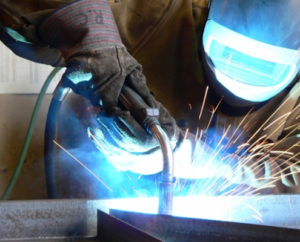 The Metal Inert Gas (MIG) or Metal Active Gas (MAG) welding is a semi-automated process, widely used in many sectors of industry, such as Fabrication, Structural, Shipbuilding, Railroad construction and production of heavy plants and machinery.
The Metal Inert Gas (MIG) or Metal Active Gas (MAG) welding is a semi-automated process, widely used in many sectors of industry, such as Fabrication, Structural, Shipbuilding, Railroad construction and production of heavy plants and machinery.
The process melts and fuses metals using the intense heat generated by an electric arc between the metals to be joined and a filler wire (solid or flux cored). The wire is progressively melted at the same speed at which it is being fed by the wire feeder and forms part of the weld pool. Both the arc and the weld pool are protected against atmospheric contamination by a shield of inert (non-reactive) gas
MMA
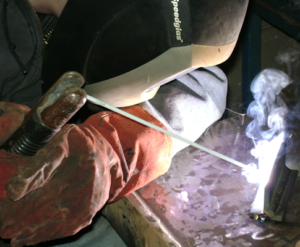 Valued for its flexibility, MMA is one of the most commonly used welding processes.
Valued for its flexibility, MMA is one of the most commonly used welding processes.
It is used on a daily basis by DIYers, Tradesmen, Security Metalwork Specialists and Metal Fabricators, as well as on pipe laying work sites. MMA welding consists of creating a high-intensity electric arc between a shielded metal-cored electrode and the metals to be joined.
The filler metal is transferred by an electric arc between gushing soul of the coated electrode and the workpiece
The heat generated by the electric arc simultaneously melts the base metal (workpiece), the metal core and the coating of the electrode, creating the melt which collects drops of filler metal and molten slag transferred into the plasma of this arc. Part of electrode components is volatilized, helping to create the atmosphere in which the arc is struck. The molten coating, low-density covers the melt forming the slag which protects the weld metal during and after solidification.
Orbital Welding
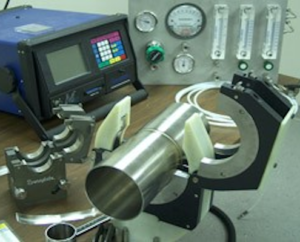 In the orbital welding process, tubes/pipes are clamped in place and an orbital weldhead rotates an electrode and electric arc around the weld joint to make the required weld. An orbital welding system consists of a power supply and an orbital weldhead.
In the orbital welding process, tubes/pipes are clamped in place and an orbital weldhead rotates an electrode and electric arc around the weld joint to make the required weld. An orbital welding system consists of a power supply and an orbital weldhead.
Power Supply: The power supply / control system supplies and controls the welding parameters according to the specific weld program created or recalled from memory. The power supply provides the control parameters, the arc welding current, the power to drive the motor in the weld head and switches the shield gas(es) on/off as necessary.
Weld Head: Orbital weld heads are normally of the enclosed type and provide an inert atmosphere chamber that surrounds the weld joint. Standard enclosed orbital weld heads are practical in welding tube sizes from 1/16 inch (1.6mm) to 6 inches (152mm) with wall thickness’ of up to .154 inches (3.9mm). Larger diameters and wall thickness’ can be accommodated with open style weld heads.
Manual Handling
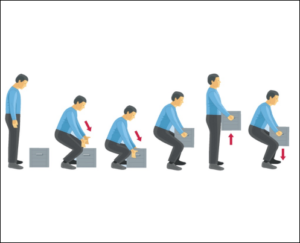 The Manual Handling training course covers a range of topics in order to give the learner confidence to risk assess manual handling tasks and perform said tasks within their workplace.
The Manual Handling training course covers a range of topics in order to give the learner confidence to risk assess manual handling tasks and perform said tasks within their workplace.
This course is intended for people who wish to receive the theory and practical skills required for correct manual handling. The Safety, Health and Welfare at Work, (General Applications) Regulations 2007, Chapter 4 of Part 2, outline the requirements that must be adhered to in relation to manual handling.
Manual Handling is a physical activity that takes place in every workplace, and in some cases the activity does not pose problem. However, it can be a potential workplace hazard when an employee is required to handled very heavy loads, which could result in a back injury. The type of manual handling activity that needs to be assessed is defined in Regulation 68 of the Safety, Health and Welfare at Work, (General Application) Regulations 2007.
Abrasive Wheels
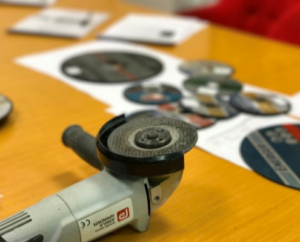 To provide abrasive wheels training course participants with the knowledge, skills and attitude to enable operative use of the abrasive wheel safely. It also provides an understanding of abrasive wheels, instructing delegates in all aspects of the correct mounting, settings and use of abrasive wheels.
To provide abrasive wheels training course participants with the knowledge, skills and attitude to enable operative use of the abrasive wheel safely. It also provides an understanding of abrasive wheels, instructing delegates in all aspects of the correct mounting, settings and use of abrasive wheels.
The course is delivered through a combination of classroom-based tutorials and practical training. Our Abrasive Wheels Training and assessment programme enables experienced drivers to gain the necessary. Successful Abrasive Wheels Training course candidates get certified after demonstrating their skills and knowledge.
Polyethylene Welding
 Polyethylene Welding is used within the Construction industry in the Gas and Water fields as well as other areas such as Electric and Waste Treatment industries.
Polyethylene Welding is used within the Construction industry in the Gas and Water fields as well as other areas such as Electric and Waste Treatment industries.
Polyethylene Welding is used within the Construction industry in the Gas and Water fields as well as other areas such as Electric and Waste Treatment industries. It is becoming more popular within the trade as it is very cost effective way of welding. Like all welding, it requires training certification and experience. At NWI we have years of experience within this field to provide the training and certification you require.
It is becoming more popular within the trade as it is very cost effective way of welding. Like all welding, it requires training certification and experience. At NWI we have years of experience within this field to provide the training and certification you require.
NDT – Non Destructive Testing
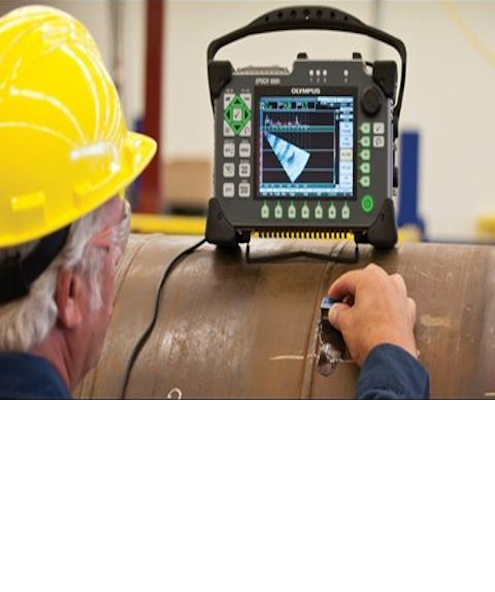
Definition of NDT
The use of noninvasive techniques to determine the integrity of material, compound, structure or quantitatively measure some characteristics of an object i.e. inspect or measure without harm.
Nondestructive testing (NDT) is the process of inspecting, testing, or evaluating materials, components or assemblies for discontinuities, or differences in characteristics without destroying the serviceability of the part or system. In other words, when the inspection or test is completed the part can still be used.
There are 6 most frequently used NDT methods, and also many others not so used methods:
- Magnetic Particle testing – MT
- Liquid Penetrant testing – PT
- Radiographic testing – RT
- Ultrasonic testing – UT
- Visual testing – VT
LEVELS
Basic – Plate Fillet & Pipe to Plate welding level in all processes starting with the easiest:
MMA – Carbon Steel
MAG – Carbon Steel
MIG – Stainless Steel & Aluminium
TIG – Stainless Steel & Aluminium
Starting with basic Welding position and progressing on to more difficult on reaching standard.
PA – Flat
PB – Horizontal / Vertical
PD – Horizontal / Overhead
PF – Vertical Up
PG – Vertical Down
Single Layer – Multi Layer
Intermediate- Open V Butt Carbon Steel & Stainless Steel
MMA – Carbon Steel
MAG – Carbon Steel
MIG – Stainless Steel & Aluminium
TIG – Stainless Steel & Aluminium
PA – Flat
PC – Horizontal
PE – Overhead
Butt weld – Single side/No backing – Single side/Metal backing – Both sides
Advanced Coded Pipe
MMA – Carbon Steel
MAG – Carbon Steel
MIG – Stainless Steel
TIG – Stainless Steel
PA – Flat
PC – Horizontal
PE – Overhead
H – LO45 – Vert Up/ 45
J – LO45 – Vert down/ 45
Butt weld – Single side/No backing – Single side/Metal backing
